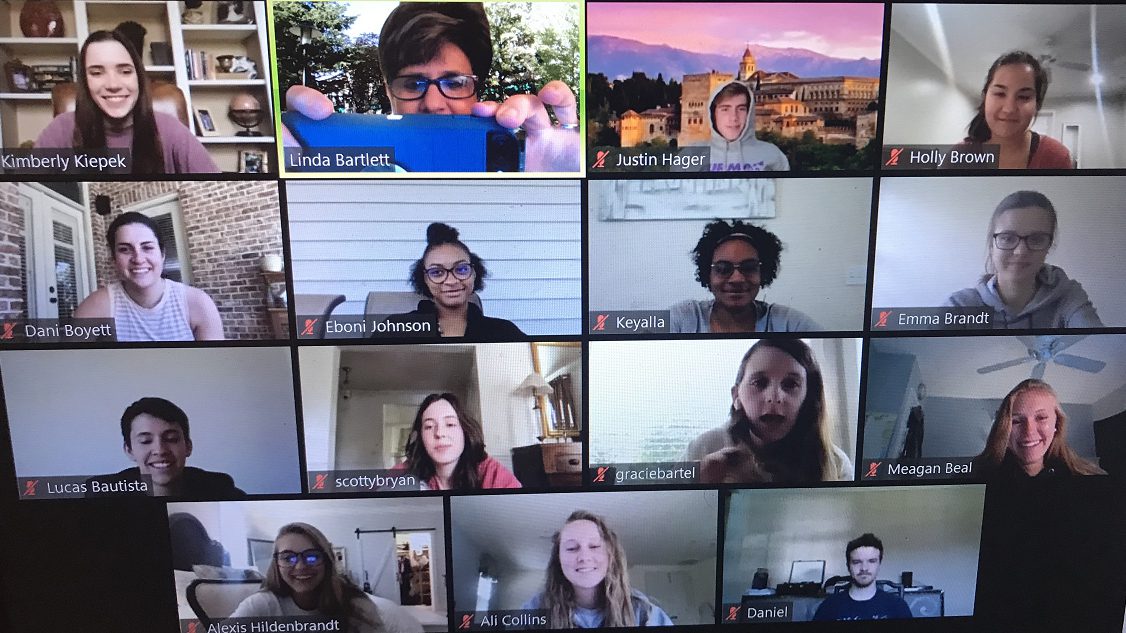Teaching in the time of COVID-19

The Furman community is much more than a physical location. Click below for a special message from our faculty and coaches:
Before the COVID-19 pandemic began wreaking havoc in higher education across the United States, leaders in the Office of Academic Affairs at Furman University rallied around a singular cause: to preserve the university’s standards of academic excellence and student engagement.
“Initially, the biggest challenge was trying to be proactive in decision making when the environment was in constant flux,” said Suzy Summers, interim dean of faculty. “Another challenge was figuring out how to support faculty who had to pivot mid-semester from in-person to remote instruction without losing the essence of a Furman education.”
From the beginning, the nine-member Academic Leadership Team, made up of administrators and faculty leaders, met daily and sometimes twice daily to shape how Furman would go forward.
“It’s a huge responsibility to make sure we are observing accreditation and meeting requirements for the students,” said Jeremy Cass, an associate academic dean. “I’m intensely proud that our focus was first setting priorities that were most meaningful to Furman,” namely establishing the level of student contact and the key elements for course content without overwhelming faculty and students.
From day one, Summers was struck by the sheer number of faculty who jumped in to offer their expertise. And to proactively shepherd emerging issues among faculty and students during the transition to online learning, the university formed an ad hoc committee composed of personnel from the Faculty Development Center, the Office of Academic Affairs, Center for Academic Success, Student Office for Accessibility Resources, Furman Libraries and academic liaisons.
While students spent an extra week on spring break, Diane Boyd and Ben Haywood, executive director and assistant director, respectively, of the FDC, met, in a virtual way, with 200 faculty members in five days. They worked with Susan Dunnavant, director of Learning Technology Services, to develop integrated workshop offerings and build “sandboxes” where faculty could tinker with and test Zoom video and other software tools, and to conduct multiple one-on-ones with faculty to get them quickly up to speed.
“We asked (faculty) to take a moment to pause and reflect on their teaching values and how they enact them,” Boyd said. “Repeatedly, colleagues mentioned interaction with students and fostering critical thinking as foundational to their courses. With that as our collective starting point, choosing which course content or goals to cut became slightly more seamless.”
“Witnessing our collective care for students and learning, and our collaboration with ITS and the library, is one of the great joys of the last few weeks, one that affirms us all as we interact in the brave new world of remote learning,” Boyd said.
“Everyone stepped up,” said Linda Bartlett, the Carey Shepard Crantford Professor of Modern Languages and Literatures and chair of the department. “I can’t thank the staff at FDC and (Information Technology Services) enough for their incredible support. They have been on the front lines providing so many training opportunities at the drop of a hat.”
The ability to reconnect, even virtually, in a suddenly disconnected world has blunted COVID-19’s isolation factor.
“Faculty are so excited to see their students again,” Cass said. “In the first few days, we had a lot of colleagues using their Zoom meetings literally to check in with students. We’ve even heard of Zoom courses with virtual hugs because students were so excited about being back together.”
Meanwhile, other groups on campus, like the senior-level Emergency Management Team and the Emergency Operations Team, both of which are made up of members from each division on campus, are meeting regularly to tackle other complex issues and address health and welfare concerns of students, faculty and staff.
While “back to normal” in higher education is clearly a moving target, and business as usual in unusual times is at best taxing, Bartlett remains hopeful about the path ahead.
“The people at Furman have again proven to be adaptable and resilient,” she said. “I think that’s encouraging to all of us.”